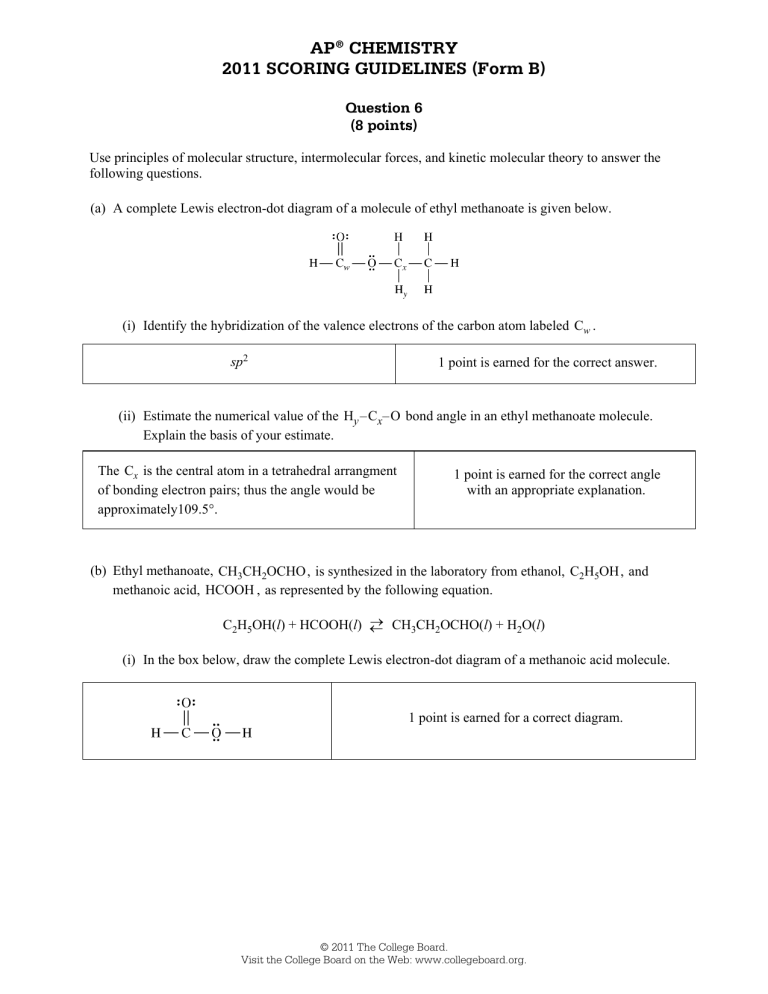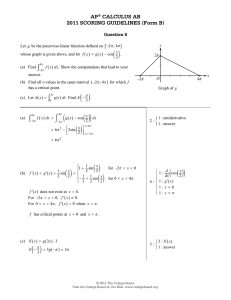AP Chemistry Scoring Guidelines: Molecular Structure & Forces
advertisement

AP® CHEMISTRY 2011 SCORING GUIDELINES (Form B) Question 6 (8 points) Use principles of molecular structure, intermolecular forces, and kinetic molecular theory to answer the following questions. (a) A complete Lewis electron-dot diagram of a molecule of ethyl methanoate is given below. (i) Identify the hybridization of the valence electrons of the carbon atom labeled Cw . sp2 1 point is earned for the correct answer. (ii) Estimate the numerical value of the Hy –Cx–O bond angle in an ethyl methanoate molecule. Explain the basis of your estimate. The Cx is the central atom in a tetrahedral arrangment of bonding electron pairs; thus the angle would be approximately109.5°. 1 point is earned for the correct angle with an appropriate explanation. (b) Ethyl methanoate, CH3CH2OCHO, is synthesized in the laboratory from ethanol, C2H5OH, and methanoic acid, HCOOH , as represented by the following equation. CH CH OCHO(l) + H O(l) C2H5OH(l) + HCOOH(l) 3 2 2 (i) In the box below, draw the complete Lewis electron-dot diagram of a methanoic acid molecule. 1 point is earned for a correct diagram. © 2011 The College Board. Visit the College Board on the Web: www.collegeboard.org. AP® CHEMISTRY 2011 SCORING GUIDELINES (Form B) Question 6 (continued) (ii) In the box below, draw the complete Lewis electron-dot diagrams of a methanoic acid molecule and a water molecule in an orientation that allows a hydrogen bond to form between them. 1 point is earned for a diagram showing a reasonable orientation between a methanoic acid molecule and a water molecule. Hydrogen Bonding Between Methanoic Acid and Water (c) A small amount of liquid ethyl methanoate (boiling point 54C) was placed in a rigid closed 2.0 L container containing argon gas at an initial pressure of 1.00 atm and a temperature of 20°C. The pressure in the container was monitored for 70. seconds after the ethyl methanoate was added, and the data in the graph below were obtained. It was observed that some liquid ethyl methanoate remained in the flask after 70. seconds. (Assume that the volume of the remaining liquid is negligible compared to the total volume of the container.) (i) Explain why the pressure in the flask increased during the first 60. seconds. Some of the liquid ethyl methanoate is going into the gas (vapor) phase. 1 point is earned for the correct explanation. © 2011 The College Board. Visit the College Board on the Web: www.collegeboard.org. AP® CHEMISTRY 2011 SCORING GUIDELINES (Form B) Question 6 (continued) (ii) Explain, in terms of processes occurring at the molecular level, why the pressure in the flask remained constant after 60. seconds. At the equilibrium vapor pressure, the rate of molecules passing from the liquid to the gas phase (vaporizing) equals the rate of gas phase molecules passing into the liquid phase (condensing). 1 point is earned for the correct explanation. (iii) What is the value of the partial pressure of ethyl methanoate vapor in the container at 60. seconds? 1.25 atm 1.00 atm = 0.25 atm 1 point is earned for the correct answer. (iv) After 80. seconds, additional liquid ethyl methanoate is added to the container at 20C. Does the partial pressure of the ethyl methanoate vapor in the container increase, decrease, or stay the same? Explain. (Assume that the volume of the additional liquid ethyl methanoate in the container is negligible compared to the total volume of the container.) The partial pressure of the vapor stays the same because the equilibrium vapor pressure for 20°C has already been reached. Because the temperature remains constant, the vapor pressure would remain unchanged. 1 point is earned for the correct answer with an explanation. © 2011 The College Board. Visit the College Board on the Web: www.collegeboard.org. © 2011 The College Board. Visit the College Board on the Web: www.collegeboard.org. © 2011 The College Board. Visit the College Board on the Web: www.collegeboard.org. © 2011 The College Board. Visit the College Board on the Web: www.collegeboard.org. © 2011 The College Board. Visit the College Board on the Web: www.collegeboard.org. © 2011 The College Board. Visit the College Board on the Web: www.collegeboard.org. © 2011 The College Board. Visit the College Board on the Web: www.collegeboard.org. © 2011 The College Board. Visit the College Board on the Web: www.collegeboard.org. © 2011 The College Board. Visit the College Board on the Web: www.collegeboard.org. © 2011 The College Board. Visit the College Board on the Web: www.collegeboard.org. © 2011 The College Board. Visit the College Board on the Web: www.collegeboard.org. AP® CHEMISTRY 2011 SCORING COMMENTARY (Form B) Question 6 Sample: 6A Score: 8 This response earned all 8 possible points. Part (a)(i) earned 1 point for the correct hybridization (sp2), and part (a)(ii) earned 1 point for the correct bond angle with justification. Part (b)(i) earned 1 point for the correct Lewis electron-dot diagram for methanoic acid, and part (b)(ii) earned 1 point for showing the orientation of the water near the acidic H atom. Part (c) earned 4 points: 1 point in part (c)(i) for correctly attributing the pressure increase to the vaporization of the methanoic acid; 1 point in part (c)(ii) for mentioning the equal rates of vaporization and condensation; 1 point in part (c)(iii) for the correct calculation of the partial pressure; and 1 point in part (c)(iv) for stating that vapor pressure is dependent on temperature only. Sample: 6B Score: 5 Part (b)(i) did not earn the point for an incorrect electron-dot diagram for the wrong molecule shown in the box, but part (b)(ii) earned 1 point for showing the orientation for the formation of a hydrogen bond even though the molecule shown is still wrong. Part (c)(ii) did not earn the point because the solid phase is discussed. Part (c)(iv) did not earn the point for incorrectly concluding that the pressure will increase. Sample: 6C Score: 2 No points were earned in part (a) for the incorrect hybridization and the incorrect bond angle. Part (b)(i) earned 1 point for the correct Lewis electron-dot diagram for methanoic acid. Part (b)(ii) did not earn the point because the diagram failed to show a reasonable orientation for the formation of a hydrogen bond. Part (c)(i) did not earn the point for the response referring to some reaction of the methanoic acid molecules, rather than its vaporization. Part (c)(ii) did not earn a point as the response does not refer to “processes occurring at the molecular level.” Part (c)(iii) did not earn the point because of confusion between the total pressure and the partial pressure of the methanoic acid. Part (c)(iv) earned 1 point for the correct answer and an acceptable explanation. © 2011 The College Board. Visit the College Board on the Web: www.collegeboard.org.

